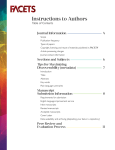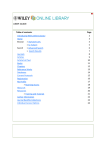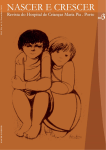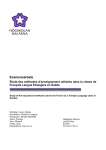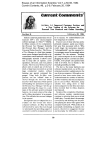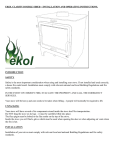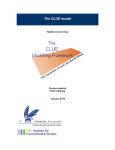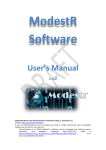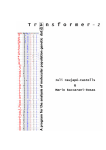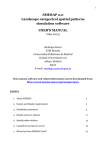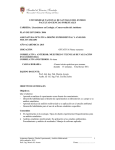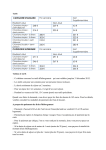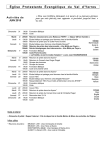Download A P R I L 2 0 1 5
Transcript
ECOGRAPHY P A T T E R N A N D D I V E R S I T Y 38 A P R I L Typeset in India by Deanta Global 2 0 1 5 I N E C O L O G Y ECOGRAPHY ECOGRAPHY is a journal issued by the Nordic Ecological Society Oikos, representing ecologists in Denmark, Finland, Iceland, Norway and Sweden. Ecologists from all countries are invited to publish original results on its pages. ECOGRAPHY publishes papers focused on broad spatial and tempo ral patterns, particularly studies of population and community ecology, macroecology, biogeography, and ecological conservation. Studies in ecological genetics and historical ecology are welcomed in the context of explaining contemporary ecological patterns. Manuscripts are expected to address general principles in ecology, though they may do so using a specific model system if this frames the problem relative to a generalised ecological issue. Papers generally are expected to be based on concise hypotheses or to relate to concise theoretical concepts based on sound natural history. Purely descriptive papers are considered only if breaking new ground and/ or describing patterns seldom explored. Manuscripts merely confirming or marginally extending results of previous work are discouraged. Papers are judged by virtue of their originality, appeal to general interest, and their contribution to new developments in ecological research concern ing spatial and temporal patterns. There is no bias with regard to taxon, biome, or biogeographical area. Ecography publishes four types of articles: • Original research papers present research focused on ecological and geographical patterns in space and time. Theoretically oriented papers are expected to synthesize and move beyond previous know ledge, preferably by suggesting new conceptual or methodological approaches to well-established problems. Among empirical studies, those that explore or test clearly stated hypotheses or theoretical predictions and attempt to generalize results to other systems are welcomed. • Forum papers are commentaries, short papers or notes about new ideas, alternative ways of evaluating existing information or respons es to recent papers in Ecography or elsewhere that deal with spatiotemporal issues in ecology. Notes focused on new or improved methods are also welcome. Contributions in this category may be submitted or solicited. • Review & Synthesis papers provide a critical assessment of the lit erature with emphasis on current topics in which rapid and signifi cant advances are occurring. Ecography papers in this category should be more focused than the broad, topical reviews typically published elsewhere, developing a synthesis that inspires new hypotheses or new methods. Contributions in this category may be submitted or solicited. • Software notes announce new software or software already in use but not previously published in a peer-reviewed journal for the study of spatial and temporal patterns in ecology. Software notes should pro vide a summary of the software that describes its benefits and potential application(s). Software notes are published with high priority and the section is intended as an outlet for the very best software tools in spatiotemporal ecology. Products that are avialable only on a commercial basis will not be considered. ECOGRAPHY appears with one volume (12 issues) annually. Order of publication is normally chronological, but may be modified based on editorial considerations. Sponsor ECOGRAPHY is published in cooperation with the journals Oikos, Lindbergia, Journal of Avian Biology, Hereditas, Nordic Journal of Botany and the monograph series Ecological Bulletins. Editor-in-Chief Prof. Miguel Araujo, Imperial College London, UK. Deputy Editors-in-Chief Nathan Sanders, Univ. of Copenhagen, Denmark. Jens-Christian Svenning, Univ. of Aarhus, Denmark. Catherine Graham, Stony Brook University, USA. Subject Editors Marti Jane Anderson, Massey Univ., New Zealand. Michel Baguette, Muséum National d’Histoire Naturelle, Brunoy, France. Robert K. Colwell, Univ. of Connecticut, USA. Alexandre Diniz-Filho, Univ. Federal de Goiás, Brasil. Carsten Dormann, Univ. of Freiburg, Ger many. Rob Dunn, North Carolina State Univ., USA. Johan Ehrlén, Stockholm Univ., Sweden. Erica Fleishman, National Center for Ecological Analysis and Synthesis, USA. Janet Franklin, Arizona State Univ., USA. Jean-Michel Gailland, UCB Lyon 1, France. Catherine H. Graham, Stony Brook Univ., USA. Russell Greenberg, Smithsonian Migratory Bind Centre, USA. Joaquin Hortal, Imperial Univ., UK. Douglas Kelt, Univ. of California, Davis, USA. Jeremy Kerr, Univ. of Ottawa, Canada. Kenneth H. Kozak, Univ. of Minnesota, USA. Jill Lancaster, Monash Univ., Australia. Erik Matthysen, Univ. of Antwerp, Belgium. David Nogues, Univ. of Copenhagen, Denmark. Kai Norrdahl, University of Turku, Finland. Thierry Oberdorff, Muséum National d’Histoire Naturelle, Paris, France. Pedro Peres-Neto, Univ. du Québec à Montréal, Canada. Eric Post, Pennsylvania State Univ., USA. Francisco Pugnaire, Consejo Superior de Investigaciones Cientificas, Almeria, Spain. Thiago Rangel, Univ. of Connecticut, USA. John R. Spence, Univ. of Alberta, Edmonton, Canada. Hanna Tuomista, Univ. of Turku, Finland. Thorsten Wiegand, UFZ Centre for Environmental Research, Germany. John J. Wiens, Stony Brook Univ., USA. Niklaus E. Zimmermann, Swiss Federal Research Inst., WSL, Switzerland. Publication Board Jacobus Boomsma, Copenhagen. Birgitta Tullberg, Stockholm. Linus Svensson, Lund. Gíslí Már Gíslason, Reykjavik. Gunilla Rosenquist, Trondheim. Marianne Fred, Åbo Akademi University. Subscriptions Journal Customer Services: For ordering information, claims and any enquiry concerning your journal subscription please contact your nearest office: UK: Email: [email protected] Tel: +44 (0) 1865 778315; Fax: +44 (0) 1865 471775 USA: Email: [email protected] Tel: +1 781 388 8599 or 1 800 835 6770 (Toll free in the USA & Canada); Fax: +1 781 388 8232 or Fax: +44 (0) 1865 471775 Asia: Email: [email protected]; Tel: +65 6511 8000; Fax: +44 (0) 1865 471775 You may also use any subscription agent or go directly via our homepage www.oikos.ekol.lu.se Please check the journal website (www.wileyonlinelibrary.com/journal/ ecog) for up to date prices. Copyright © 2015 Ecography. All rights reserved. No part of this pub lication (apart from articles marked “OnlineOpen”) may be reproduced, stored or transmitted in any form or by any means without the prior per mission in writing from the copyright holder. Authorization to photocopy items for internal and personal use is granted by the copyright holder for libraries and other users registered with their local Reproduction Rights Organisation (RRO), e.g., Copyright Clearance Center (CCC), 222 Rose wood Drive, Danvers, MA 01923, USA (www.copyright.com), provided the appropriate fee is paid directly to the RRO. This consent does not ex tend to other kinds of copying such as copying for general distribution, for advertising and promotional purposes, for creating new collective works or for resale. OnlineOpen articles are made available in accordance with the terms of the Creative Commons Deed, Attribution 2.5 (further details available from www.creative commons.org), which allows Open Access dissemination of the article, but does not permit commercial exploitation or the creation of derivative works. Special requests should be addressed to: journalsrights@ oxon.blackwellpublishing.com ECOGRAPHY (ISSN 0906-7590) is published monthly. USA sub scription price is USD 296 including airspeed delivery. US mailing agent: Mercury Airfreight International Inc., 365 Blair Road, Avenel, NJ 07001, USA. Periodical postage paid at Rahway, NJ. Postmaster: Send all address changes to ECOGRAPHY, Journal Customer Services, John Wiley & Sons Inc., 350 Main St., Malden, MA 02148-5020. Manuscripts and correspondence should be directed to the Managing Editor: Dr. Maria Persson, Department of Ecology, Lund University, Ecology Building, SE-223 62 Lund, Sweden. Phone +46 46 222 37 92. Email: [email protected], <www.ecography.org> Guide to authors General editorial practice Submit your manuscript at <http://mc.manuscriptcentral/ecogra> Authors submitting a manuscript do so on the understanding that the work follows ethical guidelines and legislation within the country where it has been carried out, that it has not been published before, that it is not being considered for publication elsewhere and that it has been read and approved by all authors. Authors will be required to sign an Exclusive Licence Form (ELF) for all papers accepted for publication. Signature of the ELF is a condition of publication and pa pers will not be passed to the publisher for production unless asigned form has been received. Please note that signature of the Exclusive Licence Form does not affect own ership of copyright in the material. After submission, authors will retain the right to publish their paper in various media/circumstances. Manuscripts are screened by the editorial board before being sent out for ex ternal review and may be rejected editorially. Editorial reject decisions are based on how well a manuscript fits the scope of the journal as well as on the quality of the manuscript. Typically, editorial reject decisions are taken within a week from submission. Manuscripts sent out for external review are evaluated based on their scientific significance and soundness. Authors will generally be notified of accep tance, rejection, or need for revision within three months. Decisions of the editor are final. Uninvited resubmissions are subject to rejection without peer review. Manuscripts are edited to improve communication between author and reader. Authors will receive electronic proofs via e-mail, together with a Query Form detailing any questions we have regarding the article, and an Exclusive License Form. Correct only printer’s mistakes. You may be charged for excessive correc tions beyond such mistakes. No offprints will be supplied. Instead authors will receive a locked PDF file to the use at their discretion. There are no page charges. Authorship. Statement on authorship. Papers should conform to recommendations for authorship provided by the International Committee of Medical Journal Editors (the Vancouver Group; see <www.icmje.org>). That is, authorship of a paper car ries with it responsibility as well as credit. All those whose names appear as authors should have played a significant role in designing or carrying out the research, writ ing the manuscript, or providing extensive guidance to the execution of the project. They should be able to present and defend the work in a public forum. Honorary au thorship is to be avoided. All authors must be in agreement on both the submission and full content of any article carrying their name. Any violation of these conditions represents academic misconduct and will be dealt with accordingly. Manuscripts Format. Manuscripts should be double-spaced throughout (including tables, figure legends, appendices, literature cited) with all lines and pages numbered. Specific information for Software notes. Abstracts for Software notes have a 100 word length limitation. Papers in this section have a 2500 word length limitation for all text, excluding tables and legends. Submitted notes should be subdivided only into an abstract, main text, acknowledgements, and references. Software notes may include a maximum of three tables/figures. They should provide the basic rationale behind the software, its basic functions, and sample usage, output, and interpreta tion. A link to a persistent website where the software may be downloaded or used must be provided. Software notes are not intended to replace proper user documen tation, and the user’s manual along with test datasets should be available form the software website. The section particularly welcomes user-friendly approaches. To ensure that software websites referred to in Software notes will be acces sible for years to come, the journal requies authors to establish a persistent internet address (PURL) for the software published in the journal. A step-by-step guide explaining how to do this is provided at the journal’s PURL page <www.oikos. ekol.lu.se/ecoPURL.html>. Language. Manuscripts should be in English. Linguistic usage should be correct. Avoid the use of the passive voice. Avoid extensive reviews in the Introduction and Discussion. Cite only essential sources of a theory or opinion. Authors for whom English is a second language may choose to have their manuscript professionally edited before submission to improve the English. A list of independent suppli ers of editing services can be found at <www.blackwellpublishing.com/bauthor/ english_language.asp>. All services are paid for and arranged by the author, and use of one of these services does not guarantee acceptance or preference for publication. Title. The title should be brief and contain words useful for indexing and infor mation retrieval. Text. The first page should contain only the title and the author’s name, ad dress and email-address. Page two contains the abstract, in which the main results of the work should be summarized. The abstract should not contain more than 300 words. Begin the introduction on page three. Avoid right mar gin justification and hyphenation. Double-check the contents of your manu script before submitting. Only printer’ mistakes in proofs will be changed free of charge. Illustrations. All illustrations should bear the author’s name. Tables and legends of illustrations should be written double-spaced on separate sheets. Do not incor porate the legend in the figure itself. Tables and illustrations should be compre hensible without reference to the text. Colour plates may be included at the author’s expense. Plan your illustrations for the smallest size possible (one column). Do not submit originals until so instructed. Units. Use SI units as far as possible. Nomenclature. Binomial Latin names should be used in accordance with International Rules of Nomenclature. References. In the list of references, the following usage should be conformed to: Journal: Phillips, B. L. and Shine, R. 2006. Spatial and temporal variation in the morphology (and thus, predicted impact) of an invasive species in Australia. – Ecography 29: 205–212. Book: Gavrilets, S. 2004. Fitness landscapes and the origin of species. – Princeton Univ. Press. Chapter: von Ende, C. N. 2001. Repeated-measures analysis: growth and other time-dependent measures. – In: Scheiner, S. and Gurevitch, J. (eds), Design and analysis of ecological experiments. Oxford Univ. Press, pp. 134–157. In the text references are given: Gavrilets (2004) or, at the end of a sentence, (Gavrilets 2004). Titles of journals should be abbreviated following Biological Abstracts. If in doubt, give the title in full. Do not refer to unpublished material. The reference list should be arranged alphabetically on authors’ names and chronologically per author. If the author’s name is also mentioned with co-authors, the following order should be used: publications of the single author, arranged chronologically – publications of the same author with one co-author, arranged chronologically – publications of the author with more than one co-author, ar ranged chronologically. When papers in the reference list have more than one co-author, please write the first author followed by et al. Publications by the same author(s) in the same year should be listed as 2004a, 2004b, etc. Reference lists not conforming to this format will be returned for revision. When in doubt, please consult the latest issue of ECOGRAPHY. Excessive use of references causes unnecessary long articles. To avoid excessive use of references, use only the most relevant. As a rule, avoid using more than 50 references in a regular research paper. Acknowledgements. Keep them short. Appendices. Relevant appendices may be posted on the journals homepage. Authors are recommended to follow the guidelines set out in: O’Connor, M. 1991. Writing successfully in science. – Harper Collins Academic, London. Manuscripts not conforming to the requirements will be returned for revision. Abstracted/indexed in: Biological Abstracts/BIOSIS, Cambridge Scientific Abstracts, Ecological Abstracts, Elsevier BIOBASE/Current Awareness in Biological Sciences, Science Citation Index, SCISEARCH, Research Alert, Current Contents: Agri culture, Biology & Environmental Sciences, Ecological Abstracts, Environmental Periodicals Bibliography, Geographical Abstracts, Key Work Index of Wildlife Research. For further information about the journal, please visit our homepage at: <www.oikos. ekol.lu.se> Cover: Top image: pbdb_map_occur function, from the paleobioDB R Package, returns a map of the number of fos sil records per cell stored in the Paleobiology Database. In this case, the image shows the records assigned to Canidae. Middle left image: Common blackbird (Turdus merula) on holly (Ilex aquifolium). Photo by Luis Ojembarrena. Center image: Description: Bia actorion (Nymphalidae, Brassolini) in Ecuadorean Amazon rainforest understory. Photo by Phil DeVries. Middle right image: The Italian festoon in the image (Zerynthia cassandra) is extremely similar in morphology to the south ern festoon (Zerynthia polyxena). This is a recently described cryptic species of butterfly that occurs on the Italian penin sula and on two islands (Sicily and Elba). The forum paper by Vodă et al. in this issue highlights the importance of includ ing the cryptic diversity in ecological, biodiversity and biogeographic studies to avoid biased results. Photo by Roger Vila. Bottom image: Blooming alpine meadow (2550 m a.s.l.) in the southwestern Alps near Lautaret pass (France). Photo by Philippe Choler.



